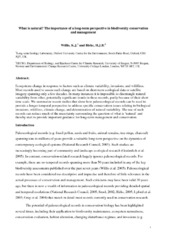| dc.contributor.author | Willis, Katherine Jane | eng |
| dc.contributor.author | Birks, Harry John Betteley | eng |
| dc.date.accessioned | 2008-02-01T08:49:20Z | |
| dc.date.available | 2008-02-01T08:49:20Z | |
| dc.date.issued | 2006 | eng |
| dc.Published | Science 2006 314 (5803): 1261-1265 | en |
| dc.identifier.issn | 0036-8075 | en_US |
| dc.identifier.uri | http://hdl.handle.net/1956/2568 | |
| dc.description.abstract | Ecosystems change in response to factors such as climate variability, invasions, and wildfires. Most records used to assess such change are based on short-term ecological data or satellite imagery spanning only a few decades. In many instances it is impossible to disentangle natural variability from other, potentially significant trends in these records, partly because of their short time scale. We summarize recent studies that show how paleoecological records can be used to provide a longer temporal perspective to address specific conservation issues relating to biological invasions, wildfires, climate change, and determination of natural variability. The use of such records can reduce much of the uncertainty surrounding the question of what is ‘natural’ and thereby start to provide important guidance for long-term management and conservation. | en_US |
| dc.language.iso | eng | eng |
| dc.publisher | American Association for the Advancement of Science | en_US |
| dc.title | What is natural? The importance of a long-term perspective in biodiversity conservation and management | en_US |
| dc.type | Peer reviewed | |
| dc.type | Journal article | |
| dc.identifier.doi | https://doi.org/10.1126/science.1122667 | |
| dc.subject.nsi | VDP::Matematikk og Naturvitenskap: 400::Zoologiske og botaniske fag: 480 | nob |
